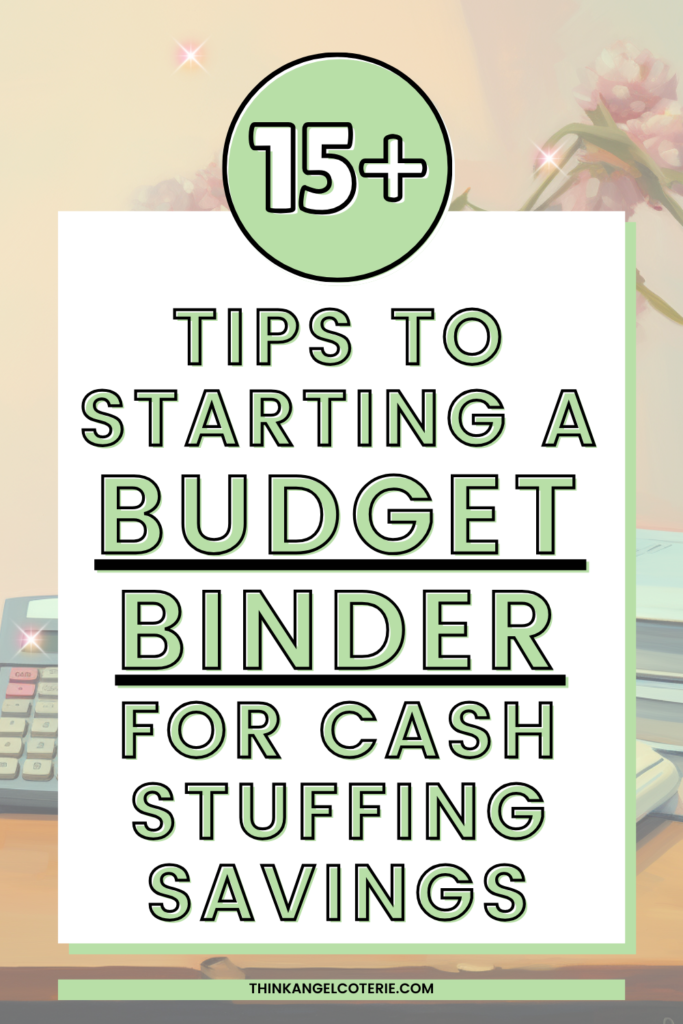Budgeting is a crucial aspect of financial management, and one effective method to keep track of your finances is by using a budget binder, also known as a cash stuffing binder. This comprehensive guide will walk you through everything you need to know about starting and maintaining a budget binder to take control of your finances effectively.
This blog post contains affiliate links. As an affiliate, I earn a commission from qualifying purchases. This means that if you click on a link or image and make a purchase, I may earn a small commission at no extra cost to you. This helps support the maintenance of the blog and allows me to continue bringing you valuable content. Thank you for your support!

Hot to Get Started With Cash Stuffing
It’s important to note that while the information provided here is based on research and personal experience, I am not a financial advisor. The decision to start a budget binder/cash stuffing binder or engage in any financial activity is a personal one. It’s recommended that individuals conduct their own research and consult with a qualified financial advisor before making any significant financial decisions. Each individual’s financial situation is unique, and what works for one person may not necessarily work for another.
Understanding the Purpose:
- A budget binder serves as a centralized hub for organizing your financial information, tracking expenses, setting goals, and managing your cash flow.
- It helps you stay accountable, avoid overspending, and work towards your financial objectives.
Essential Components of a Budget Binder:
- Binder: Choose a sturdy binder with dividers to keep your documents organized. You can find my personal favorite and the one I’m using here: SKYDUE Budget Binder, Money Saving Binder with Zipper Envelopes, Cash Envelopes and Expense Budget Sheets for Budgeting
- Expense Tracking Sheets: Create or print templates for tracking your income, expenses, and savings goals.
- Envelopes: Allocate envelopes for different expense categories such as groceries, utilities, entertainment, etc.
- Cash: Use cash to fund your envelopes based on your budgeted amounts for each category.
- Calculator: Keep a calculator handy for quick calculations and budget adjustments. You can find my personal favorite and the one I’m using here: Mechanical Switch Calculator | Handheld for Daily and Basic Office | 10 Digit Large LCD Display | Pink
Setting Up Your Budget Binder:
- Determine Your Budget Categories: List all your monthly expenses and allocate a budget for each category.
- Create Expense Tracking Sheets: Design or download printable templates for tracking your income, expenses, and savings goals.
- Label Envelopes: Label envelopes for each budget category and allocate cash accordingly.
Implementing the Cash Stuffing Method:
- Allocate Cash: Distribute cash into the designated envelopes based on your budgeted amounts for each category.
- Use Cash for Expenses: Use cash from the corresponding envelope when making purchases within each category.
- Track Spending: Record all transactions and expenses in your budget binder to monitor your spending habits.
Tips for Success:
- Review Regularly: Set aside time each week or month to review your budget binder, track your expenses, and adjust your budget as needed.
- Stay Disciplined: Stick to your budget and avoid overspending by using cash for purchases whenever possible.
- Adjust as Necessary: Be flexible with your budget and make adjustments as your financial situation or priorities change.
- Have a separate binder for when you go out and spend. Allocate some of what you will be spending here when you go out for your everyday life. You can use a A8 wallet binder for this or, some may prefer the A6 size especially if you have a big enough bag to hold it. You can find my favorite A8 wallet binder here: Zuozee Mini Budget Binder with Cash Envelopes A8 Binder Wallet. This will also ensure your cash is safe at home, and you are practicing discipline when sticking to your budget for each category.
Benefits of Using a Budget Binder:
- Improved Financial Awareness: Gain a better understanding of your spending habits and financial goals.
- Accountability: Stay accountable for your spending and savings goals by tracking your expenses regularly.
- Reduced Stress: Eliminate the stress of overspending and financial uncertainty by having a clear budgeting system in place.
Common Cash Stuffing Phrases You Should Know
Sinking Funds
Sinking funds are savings set aside for specific future expenses or goals, such as annual insurance premiums, holiday gifts, or vehicle repairs. These funds are separate from emergency savings and help individuals prepare for known upcoming expenses.
Cash Stuffing
Cash stuffing involves physically allocating cash into designated envelopes or compartments within a wallet or binder, corresponding to different budget categories. This method helps individuals manage their spending by limiting them to the cash available in each category.
Budget Allocation
Budget allocation refers to the process of distributing a predetermined amount of money into specific categories or envelopes within a budgeting system. It ensures that funds are appropriately allocated for various expenses, such as groceries, utilities, entertainment, etc.
Budget Discipline
Budget discipline involves exercising self-control and adhering to the budgeted amounts and spending limits set within a budgeting system. It is essential for achieving financial goals and avoiding overspending.
Cash Envelope System
The cash envelope system is a budgeting method where cash is allocated into different envelopes or categories representing various expenses. Each envelope contains a specific amount of cash designated for that expense category, helping individuals stay within their budgeted limits.
Savings Challenges
Savings challenges are structured programs or initiatives designed to encourage individuals to save money regularly. These challenges often involve setting specific savings goals and timelines, such as saving a certain amount each month or completing a savings challenge over a set period.
Zero-Based Budget
A zero-based budget is a budgeting method where income minus expenses equals zero. Every dollar earned is allocated to expenses, savings, or debt repayment, ensuring that all income is accounted for and leaving no room for overspending.
Magic Month
Magic Month refers to a month in which an individual receives an extra paycheck or income due to being paid three times within that month. It can provide an opportunity to make extra debt payments, boost savings, or accelerate progress towards financial goals.
Snowball Method
The snowball method is a debt repayment strategy where debts are paid off starting with the smallest balance first, regardless of interest rates. Once the smallest debt is paid off, the money previously allocated to it is then applied to the next smallest debt, creating a snowball effect that accelerates debt repayment.
No Spend Week
A no spend week is a period during which individuals commit to refraining from making any unnecessary purchases or spending money on non-essential items. It’s a temporary challenge aimed at reducing expenses, increasing savings, and cultivating mindful spending habits. Participants typically focus on utilizing what they already have, finding free or low-cost alternatives, and avoiding impulse purchases to achieve their financial goals.
By understanding these common phrases in cash stuffing and budgeting, individuals can better manage their finances, achieve their financial goals, and build a secure financial future.
50 Cash Stuffing Envelope Category Ideas
- Groceries
- Utilities (Electricity, Water, Gas)
- Transportation (Fuel, Public Transit)
- Dining Out/Fast Food
- Entertainment (Movies, Concerts, Events)
- Clothing/Apparel
- Health & Wellness (Medications, Doctor’s Visits)
- Personal Care (Toiletries, Haircuts, Beauty Products)
- Household Supplies (Cleaning Products, Paper Goods)
- Home Maintenance/Repairs
- Insurance (Auto, Home, Health)
- Savings Goals (Emergency Fund, Vacation Fund)
- Gifts (Birthdays, Holidays)
- Charity/Donations
- Education/Books
- Pets (Food, Vet Visits)
- Hobbies/Leisure Activities
- Travel (Weekend Getaways, Airfare)
- Dining In (Groceries specifically for home-cooked meals)
- Miscellaneous/Unplanned Expenses
- Kids’ Expenses (School Supplies, Activities)
- Work Expenses (Professional Development, Work Clothing)
- Electronics/Gadgets
- Subscriptions (Magazines, Streaming Services)
- Home Decor/Furniture
- Car Maintenance/Repairs
- Retirement Savings
- Investments
- Emergency Home Fund
- Personal Development (Courses, Workshops)
- Wedding Fund
- Date Nights
- Home Renovation Projects
- Outdoor Activities (Camping, Sports Equipment)
- Baby Expenses (Diapers, Formula)
- Legal/Professional Fees
- Home Office Supplies
- Gifts for Friends/Family
- Annual Memberships (Gym, Clubs)
- Hobby Supplies (Crafting, DIY Projects)
- Technology Upgrades
- Beauty Treatments (Massages, Facials)
- Garden/Landscaping
- Childcare/Babysitting
- Special Occasions (Anniversaries, Graduations)
- Emergency Car Fund
- Travel Insurance
- Retirement Fund
- Student Loans
- Fun Money (Miscellaneous Spending for Enjoyment)
These categories cover a broad spectrum of expenses, allowing you to allocate your cash effectively and manage your budget with precision. Customize and adjust these categories to align with your specific financial goals and lifestyle needs.
Starting a budget binder/cash stuffing binder is a powerful tool for taking control of your finances and achieving your financial goals. By implementing the steps outlined in this guide and staying committed to your budgeting journey, you can pave the way for a more secure and financially stable future. Take charge of your finances today and start building your budget binder to experience the benefits firsthand.

Love Think Angel Posts? Here is a post I personally chose that I think you might enjoy: 8 Lovely Tips to Get Into Your Feminine Energy




Leave a Reply